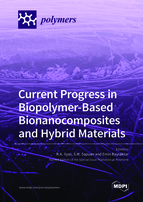Current Progress in Biopolymer-Based Bionanocomposites and Hybrid Materials
A special issue of Polymers (ISSN 2073-4360). This special issue belongs to the section "Polymer Composites and Nanocomposites".
Deadline for manuscript submissions: closed (30 June 2022) | Viewed by 31205
Special Issue Editors
Interests: natural fibre composites; material selection; biobased packaging
Special Issues, Collections and Topics in MDPI journals
Interests: polymer engineering; material engineering; natural fibers; bio-composites; nanocomposites
Special Issues, Collections and Topics in MDPI journals
Interests: advanced manufacturing processes (sinter forging, thixoforming); damage mechanisms of materials (metallic, intermetallic, rubber and epoxy-based composites); design of new composites and damage characterization; design and manufacturing of recycled constituent composites
Special Issues, Collections and Topics in MDPI journals
Special Issue Information
Dear Colleagues,
In recent years, the development of biopolymers based on constituents obtained from natural resources has been gaining much attention. The exploitation of biopolymers to engineer advanced bionanocomposites and hybrid materials is the focus of increasing scientific activity, explained by the growing environmental concerns and the interest in the novel features and multiple functionalities of these macromolecules.
The term bionanocomposites was introduced several years ago, to express an emerging class of bionano and bionanohybrid materials, resulting from the reinforcement of biopolymers such as proteins (gelatin, casein, soy and gluten), polysaccharides (cellulose, starch, chitosan, pectin, alginate, carrageenan and glycogen), lipids (cutin), and nucleic acids with inorganic or organic solids at the nanoscale. Such organic fractions comprise nanocrystalline cellulose, nanofibrillated cellulose, bacterial nanocellulose, and lignin nanoparticles, whereas inorganic fractions consist of finely divided solids, spanning from clays to phosphates or carbonates, whose origins can be either synthetic or natural.
As will become increasingly clear for the reader throughout the collection of authoritative research and reviews in this Special Issue, the relevance of coupling biopolymers with organic and inorganic nanomaterials, through innovative architectures, is twofold. First, it contradicts the idea that biopolymers are either eco-friendly or high performance. Second, it demonstrates how the properties resulting from these biopolymers are highly significant in applications such as food packaging, water treatment, gas-diffusion barriers, electronic devices, agriculture, sensing devices, flame retardancy, automotive parts, adhesives, regenerative medicine, tissue engineering, and drug delivery.
In this Special Issue, we aim to capture the cutting edge of the state of the art in research pertaining to biopolymer-based bionanocomposites and hybrid materials, and their advanced applications. Contributions on the processing of biopolymers and bionanocomposites, the use of diverse biopolymer sources such as polysaccharides, the reinforcement of nanosized materials with biopolymers, and applications of these biopolymers, bionanocomposites and biohybrid materials will constitute the backbone of this Special Issue.
Prof. Dr. S.M. Sapuan
Dr. R.A. Ilyas
Dr. Emin Bayraktar
Guest Editors
Manuscript Submission Information
Manuscripts should be submitted online at www.mdpi.com by registering and logging in to this website. Once you are registered, click here to go to the submission form. Manuscripts can be submitted until the deadline. All submissions that pass pre-check are peer-reviewed. Accepted papers will be published continuously in the journal (as soon as accepted) and will be listed together on the special issue website. Research articles, review articles as well as short communications are invited. For planned papers, a title and short abstract (about 100 words) can be sent to the Editorial Office for announcement on this website.
Submitted manuscripts should not have been published previously, nor be under consideration for publication elsewhere (except conference proceedings papers). All manuscripts are thoroughly refereed through a single-blind peer-review process. A guide for authors and other relevant information for submission of manuscripts is available on the Instructions for Authors page. Polymers is an international peer-reviewed open access semimonthly journal published by MDPI.
Please visit the Instructions for Authors page before submitting a manuscript. The Article Processing Charge (APC) for publication in this open access journal is 2700 CHF (Swiss Francs). Submitted papers should be well formatted and use good English. Authors may use MDPI's English editing service prior to publication or during author revisions.
Keywords
- biopolymers
- polysaccharides
- proteins
- lipid
- nanocellulose
- nanoclay
- natural fibres
- synthetic fibres
- polymer composites
- nanocomposites
- hybrids
- advanced application









